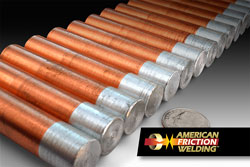Friction Welding a Stronger Bond Than Brazing or Soldering Aluminum to Copper
Friction welding is a superior method for joining copper to aluminum components. The process never uses filler metals and requires minimum pre-weld joint preparation, as it displaces oils, oxidation, and other contaminations during the welding phase. The dissimilar metals reach a plasticized state before forging, creating a very narrow heat-affected zone (HAZ), protecting the molecular structure of the components. Friction welding creates a bond as strong as the parent materials. Soldering and brazing aluminum to copper causes erosion or melting of the base metals when exposed to excessive heat; it involves much surface preparation and requires filler metal and flux to create the bond.
Mixing aluminum and copper components is widespread in lithium battery construction, electric vehicle, and other electrical contact applications. Copper is one of the most efficient electrical conductive and heat-transferring metals, while aluminum is much lighter in weight, lower in cost, and a more manageable working material. The two metals have their unique advantages and disadvantages, but the ability to combine them with a full-strength friction weld delivers a multitude of solutions. American Friction Welding is ready to serve your micro to large-format friction welding needs!

Large and Medium Copper to Aluminum Friction Weldments

Medium Machined Copper Aluminum Weldment

Successful Copper Aluminum Weld Bend Test

.5” ∅ x 2.5” Copper Aluminum Weldments
- Melting Point: 1,984°F | 1,085°C
- Electrical Conductivity: 3.5×107 S/m (siemens per meter)
- Thermal Conductivity: 398 W/m-K (watts per meter per kelvin)
- Melting Point: 1,221°F | 660.3°C
- Electrical Conductivity: 5.98×107 S/m (siemens per meter)
- Thermal Conductivity: 247 W/m-K (watts per meter per kelvin)
Other Welding Combinations: Carbon Steel to Stainless Steel, Copper to Aluminum, Hastelloy Welding, Inconel to Inconel, Nitronic 50, Stainless Steel to Mild Steel, Stainless to Stainless
